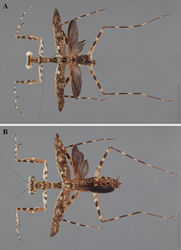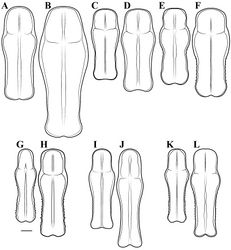Liturgusa milleri
| Notice: | This page is derived from the original publication listed below, whose author(s) should always be credited. Further contributors may edit and improve the content of this page and, consequently, need to be credited as well (see page history). Any assessment of factual correctness requires a careful review of the original article as well as of subsequent contributions.
If you are uncertain whether your planned contribution is correct or not, we suggest that you use the associated discussion page instead of editing the page directly. This page should be cited as follows (rationale):
Citation formats to copy and paste
BibTeX: @article{Svenson2014ZooKeys390, RIS/ Endnote: TY - JOUR Wikipedia/ Citizendium: <ref name="Svenson2014ZooKeys390">{{Citation See also the citation download page at the journal. |
Ordo: Mantodea
Familia: Liturgusidae
Genus: Liturgusa
Name
Liturgusa milleri Svenson, 2014 sp. n. – Wikispecies link – ZooBank link – Pensoft Profile
Type
Holotype Male, pinned. Cleveland Museum of Natural History, Cleveland, OH, USA.
Type locality
French Guiana: Kaw Mountain Res., Amazonas Lodge, 8-19 Feb 2005, Coll: K.B. Miller (Lat. 4.549389, Long. -52.213806).
Material examined
Liturgusa milleri sp. n.
| Sex | Type | Country | Label | Latitude Longitude | Code |
|---|---|---|---|---|---|
| Male | Holotype | French Guiana | Kaw Mountain Res., Amazonas Lodge, 4°32'57.8"N, 52°12'49.7"W, 8-19 Feb 2005, Coll: K.B. Miller | 4.549389, -52.213806 | GSMC000264 |
| Female | Allotype | French Guiana | Kaw Mountain Res., Amazonas Lodge, 4°32'57.8"N, 52°12'49.7"W, 8-19 Feb 2005, Coll: K.B. Miller | 4.549389, -52.213806 | GSMC000260 |
| 3 Females | Paratypes | French Guiana | Kaw Mountain Res., Amazonas Lodge, 4°32'57.8"N, 52°12'49.7"W, 8-19 Feb 2005, Coll: K.B. Miller | 4.549389, -52.213806 | GSMC000266, GSMC000314, GSMC003470 |
| Male | Paratype | French Guiana | Kaw Mountain Reserve, vicinity of Patawa, 30.IV/1.V.2011, 4.56888N, 52.21388W, elev. 282 m (at light), J. Rivera leg. | 4.568880, -52.213880 | GSMC003471 |
| Female | Paratype | French Guiana | St-Laurent du Maroni, Collection Le Moult, Coll. L. Chopard, 1919 | 5.487038, -54.008462 | MNHN 017 |
| Female | Paratype | French Guiana | Arataye Affl Approuagues, Skm NE pied Saut Parare, 1-VI-1988, Chasse de nuit, L. Desutter & P. Grandcolas rec. | 4.046724, -52.698087 | MNHN 021 |
| Female | Paratype | French Guiana | Crique Venus, IX-1992, P. Peters | 5.181326, -52.926674 | MNHN 023 |
| Female | Paratype | French Guiana | Sinnamary, 3-6-VII-1977, Guyane, M. Descamps rec. | 5.370512, -52.960320 | MNHN 025 |
| Male | Paratype | French Guiana | St-Jean du Maroni, R. Benoist, 1914 | 5.487038, -54.008462 | MNHN 035 |
| Female | Paratype | French Guiana | St-Laurent du Maroni, Collection Le Moult, Coll. L. Chopard, 1919, Juliet | 5.487038, -54.008462 | MNHN 052 |
| Female | Paratype | French Guiana | St-Jean du Maroni, R. Benoist, 1914, Mars | 5.487038, -54.008462 | MNHN 053 |
| Female | Paratype | French Guiana | Nouveau Chantier, collection Le Moult, Coll. L. Chopard, 1919, Mai | MNHN 054 | |
| Male | Paratype | French Guiana | Camopi, F. Geay - 1900 | 3.167700, -52.339455 | MNHN 072 |
| Male | Paratype | French Guiana | Massikiri-Oyapock, 16-Nov-1969, Balachowski-Gruner, Oct.Nov. 1969 | MNHN 073 | |
| Male | Paratype | French Guiana | S. Boucher, 1984-85 | MNHN 076 | |
| Female | Paratype | French Guiana | NE, Route de Kaw, Caiman Camp env. 7.XII.2006, Snizek | MSMC 003 | |
| Female | Paratype | French Guiana | St-Laurent du Maroni | 5.487038, -54.008462 | OUMNH 009 |
| Male | Paratype | French Guiana | GSMC003015 |
Diagnosis
This small species can be identified based on its slender size, its geographic restriction to the Guianas as well as the two symmetrically located white spots in the proximal quarter of their forewings. The other two species that resemble Liturgusa milleri are restricted to the island of Dominica and Central America (Liturgusa dominica and Liturgusa cursor, respectively).
Description
Male. (Fig. 22A) N=6: Body length 19.54–19.91 (19.67); forewing length 11.59–12.72 (12.07); hindwing length 9.26–10.19 (9.72); pronotum length 6.32–7.16 (6.69); prozone length 1.84–2.12 (1.95); pronotum width 1.90–2.10 (2.02); pronotum narrow width 1.27–1.39 (1.32); head width 4.42–4.74 (4.53); head vertex to clypeus 1.68–1.79 (1.72); frons width 1.46–1.63 (1.53); frons height 0.57–0.62 (0.59); prothoracic femur length 5.78–6.30 (5.92); mesothoracic femur length 7.96–8.70 (8.26); mesothoracic tibia length 6.11–7.09 (6.54); mesothoracic tarsus length 4.64–6.06 (5.58); metathoracic femur length 7.73–9.03 (8.46); metathoracic tibia length 8.22–9.55 (8.76); metathoracic tarsus length 8.80–9.35 (9.15); pronotal elongation measure 0.27–0.31 (0.29); pronotal shape measure 0.28–0.33 (0.30); head shape measure 0.38; frons shape measure 0.37–0.41 (0.39); anteroventral femoral spine count 13–15 (15); anteroventral tibial spine count 10; posteroventral tibial spine count 7. Head (Fig. 43I): Transverse, the juxta-ocular protuberances small, the apex in the lateral half; the vertex between the parietal sutures is slightly concave, uneven; vertex lower than the dorsal margin of the eyes. Frontal suture with a medial carina forming a continuous arc, but depressed into the anterior surface of the head. Ocelli small and protruding on small cuticular mounds. Lateral ocelli oriented outward, a few degrees off perpendicular. Clypeus highly transverse, the upper margin convex, the lateral and lower margin forming a continuous rounded margin. Antennae pale at the base, the scapes with two dark marks, the flagellum fading to black within a few antennomeres from the base. Broad black band extending straight over the medial carina of the frontal suture, the carina remaining white; two white spots between the lateral ocelli; lower region of frons with a black band; the clypeus with two black spots in the upper lateral corners; the mandibles and labrum pale; the vertex and juxta-ocular protuberances pale, but with four black marks, two positioned on each side of the parietal sutures; the area adjacent to lateral ocelli black. Palpi are pale.
Pronotum (Fig. 48K): Highly elongate with a defined supra-coxal bulge; dorsal surface entirely smooth. Prozone elongate with slightly convex lateral margins that taper anteriorly; the margins smooth. Metazone with strongly concave lateral margins, a slight bulge in the posterior half; margins with numerous small tubercles; posterior margin with a strong medial emargination; the dorsal surface of the posterior third of the metazone barely depressed. Pale with strong black marks across the surface, swirls present at the supra-coxal bulge.
Prothoracic Legs: Femur elongate with a slightly concave dorsal margin; tubular in overall shape with the dorsal margin less defined, the anterior and posterior surfaces almost continuous; strongly defined pale to dark banding on posterior (external) surface; anterior (internal) surface with a black band running medially from the base to terminus; the ventral surface pale. Posterior surface of femur with few tubercles. A well developed femoral pit to accommodate terminal posteroventral tibial spine positioned medial and just distal to the first most proximal posteroventral spine and in line with the distal most discoidal spine; pit is black. Posterior prothoracic femoral genicular spine smaller than all other posteroventral spines, originating just proximal to the beginning of the genicular lobe. Prothoracic tibial posteroventral spines with the first (proximal) smallest and the fourth through sixth of similar length, the second and third are longer. Prothoracic coxae smooth; the anterior surface with a broad, black band medially in the proximal half as well as a black spot medially towards the distal terminus.
Meso- and Metathoracic Legs: Femora with ventral (posterior) carina; dorsal (anterior) carina faint. Mesotarsi with first segment longer than remaining segments combined.
Wings: Forewings mottled with pale, black, and brown coloration; the costal region with pale or whitish and dark irregular banding; two bright pale spots are positioned in the proximal quarter of the discoidal region just posterior to the first radial vein. Forewings colored symmetrically; extending just beyond the terminus of the abdomen. Hindwings smoky black, but translucent, the discoidal region darker and more opaque; the costal region pale proximally and narrowing to the anterior margin distally, the pale margin continuing across the terminal margin of the discoidal region; the margin of the anal region black; the terminus of the discoidal region barely projecting beyond the distal margin of anal region, the distal margin strongly emarginate between the anal and discoidal region.
Abdomen: Elongate, tubular with slight widening before posterior narrowing; a smooth and black colored dorsal surface. Supra-anal plate transverse, tapering quickly to a blunt and wide terminus. Subgenital plate irregularly rounded and without styli.
Genital Complex (Fig. 52E.1): The main body of ventral left sclerite (L4A) with a slight medial bulge, but mostly a rounded terminus, lacking a distal process (pda); sometimes a depression on the lateral half is present. The apofisis falloid (afa) of the main body of dorsal left sclerite (L4B) elongate and robust, tapering to a strong point, one margin being concave and the other being convex; the apical process (paa) broad, shortened, cylindrical and curved, the terminus with a rounded end. The right dorsal phallomere (fda) of the first sclerite of right phallomere (R1) tapers to a rounded terminus, both margins sclerotized with a broad central membranous gap; the ventral plate (pia) smooth and broad; the ventral process (pva) smooth and tapering to a point distally, one edge straight and the other convex.
Female. (Fig. 22B) N=9: Body length 22.70–26.63 (25.22); forewing length 13.52–14.75 (14.15); hindwing length 9.65–11.33 (10.58); pronotum length 7.64–8.32 (7.97); prozone length 2.18–2.41 (2.32); pronotum width 2.36–2.60 (2.48); pronotum narrow width 1.43–1.75 (1.57); head width 5.29–5.66 (5.48); head vertex to clypeus 2.09–2.33 (2.18); frons width 1.94–2.12 (2.03); frons height 0.68–0.90 (0.77); prothoracic femur length 6.90–7.62 (7.28); mesothoracic femur length 9.07–9.82 (9.47); mesothoracic tibia length 7.24–8.13 (7.61); mesothoracic tarsus length 6.31–7.11 (6.75); metathoracic femur length 9.25–9.96 (9.67); metathoracic tibia length 9.89–10.75 (10.17); metathoracic tarsus length 9.46–10.65 (10.32); pronotal elongation measure 0.28–0.30 (0.29); pronotal shape measure 0.29–0.34 (0.31); head shape measure 0.38–0.41 (0.39); frons shape measure 0.34–0.42 (0.38); anteroventral femoral spine count 14–15 (15); anteroventral tibial spine count 10; posteroventral tibial spine count 7.
Head (Fig. 43J): Juxta-ocular protuberances large, the apex in the middle; the vertex between the parietal sutures is concave; vertex even or just higher than the dorsal margin of the eyes. Lower region of frons with black marks laterally and a central black mark, two pale gaps on each side of the central black mark; the mandibles pale with brown markings distally.
Pronotum (Fig. 48L): As described for males.
Prothoracic Legs: Prothoracic coxae smooth; the anterior surface with a broad, black band medially in the proximal half as well as a black spot medially in the distal half.
Meso- and Metathoracic Legs: Mesotarsi with first segment as long or slightly longer than remaining segments combined.
Wings: Forewings shorter than abdomen, often terminating prior to the narrowing of the abdomen.
Abdomen: Widening from first segment until the beginning of the distal half (segments 4–5) when the lateral margins narrow to the terminus, the middle being the broadest region. Tergites without posterolateral tergal projections. Supra-anal plate slightly transverse, rounded.
Etymology
A noun in the genitive case, Liturgusa milleri is named for Kelly B. Miller for his contributions to Mantodea sampling and his valuable collaboration.
Original Description
- Svenson, G; 2014: Revision of the Neotropical bark mantis genus Liturgusa Saussure, 1869 (Insecta, Mantodea, Liturgusini) ZooKeys, 390: 1-214. doi
Images
|



